Threaded fasteners including bolts, studs and nuts of different types are widely used for joining parts together. There is a bewildering variety of types, with different thread forms and different shapes or sizes.
In this section you will learn about the common types of threaded fasteners, their particular purpose, and the terms used to describe standard thread forms and fasteners.
At the completion of this section you should be able to:
Bolts, nuts or other threaded parts are used on practically every machine, engine, or structure. Obviously, the screw thread is an important feature of engineering construction.
Standard products are manufactured to the Australian Standard (AS) specifications, which are designed wherever possible to allow interchangeability with corresponding International (ISO), American (ANS) and British (BS) standards.
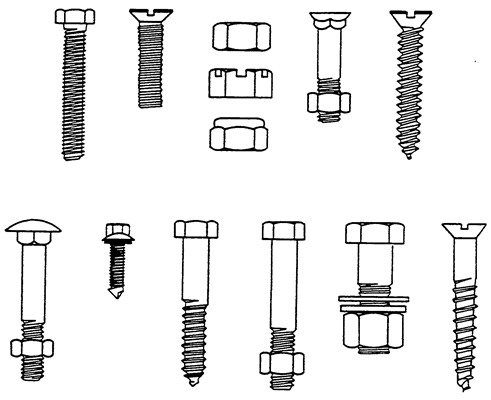
Figure 1: A range of threaded fasteners
Metric fasteners are manufactured to the Australian standard specifications for ISO metric screw threads. Figure 1 shows a range of threaded fasteners.
A screw thread (or simply ‘thread’) is the set of uniform helical grooves and ridges. An external thread is the thread on the outside of a member, as on a bolt or stud (Figure 2). An internal thread is the thread on the inside of a member, as in a nut for a bolt.
A parallel screw thread is one formed on a cylinder, and a taper screw thread is one formed on a cone.
A screw thread is said to be right handed if, when looking on the end of a threaded bar, it’s mating nut moves away from you when rotated in a clockwise direction. If you look at a right hand thread, Figure 2, it will be seen that the helix leans or slopes to the left.
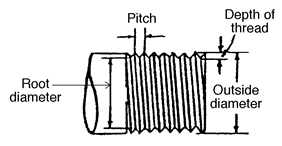
Figure 2: An external right hand thread
A screw thread is said to be left handed if, when looking on the end of the bar, it’s mating nut moves towards you when rotated in a clockwise direction. The left hand thread or helix leans or slopes to the right (Figure 3). Standard practice is to use a right hand thread; the left hand thread being only used where some special requirement makes its use desirable.

Figure 3: Left hand thread
The spanner or driver must be turned in a clockwise direction to tighten a right-hand nut or screw, and in an anti-clockwise direction to tighten a left hand one.
The turnbuckle (Figure 4) is an example of the combined use of a right hand and left hand thread. It is used to draw together tension rods in roof structures, underframes, guy ropes on masts, etc.

Figure 4: Turnbuckle
Figure 5 shows the important names for the thread dimensions.
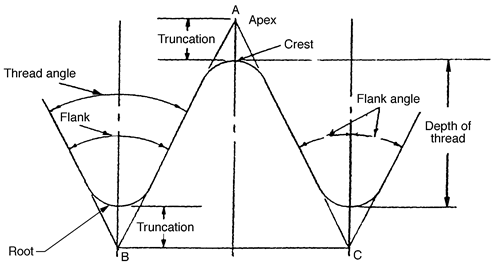
Figure 5: Thread terminology
The crest is the top of the prominent part of the thread. Similarly, the root of thread is the bottom of valley between crests. The flanks are the sloping sides of the helix, between the crest and root. The depth is the radial distance between a thread’s crest and root.
The angle of a thread is the angle between the flanks measured in an axial plane section. The fundamental triangle of a thread is the triangle ABC formed by the intersection of the extended flanks.
The pitch of a screw thread is the distance, measured parallel to the axis, between corresponding points on adjacent threads. Thus in Figure 2 the pitch is shown as the distance from crest of one thread to the crest on the next thread.
The lead is the distance the thread advances axially in one revolution. In single-start threads (where there is only a single helix forming the thread) the pitch and lead are identical. In multiple-start threads, adjacent crests belong to different helices, so the lead will be equal to the pitch time the number of ‘starts’.
The major diameter (also outside or full diameter) of an external thread is the diameter of an imaginary cylinder which just touches the crests of the threads. Note that a conduit is a cylinder and so the major diameter of a conduit thread (or threaded conduit) is the stated conduit diameter. The minor diameter (also root or core diameter) is the diameter of the imaginary cylinder which passes through the roots of an external thread.
The effective diameter of a parallel thread is the diameter of an imaginary cylinder whose surface cuts the thread where its thickness is half the pitch.
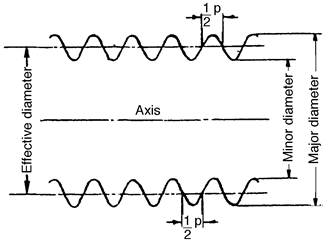
Figure 6: Thread diameters
The tolerances allowed on screw thread dimensions depend on the class of fit required. In general there are three classes of fit:
For example, high strength steel bolts used in structural engineering are made to tolerances in the medium class. Ordinary bolts, screws and nuts purchased as stock from suppliers are made to tolerances in the free class.
Table 1 shows the principal threads types in use, and their symbols. The thread forms mentioned are only some of the wide range used in engineering. There are tables of sizes and dimensions for each type. These are available in manufacturer’s catalogues, Australian Standards and engineering handbooks.
Table 1: Thread forms and their symbols
Name |
Symbol |
British Standard Whitworth |
BSW |
British Standard Fine |
BSF |
British Standard Pipe – (Parallel) |
BSP (Parallel) |
British Standard Pipe – (Taper) |
BSP (Taper) |
British Association |
BA |
Acme |
– |
Worm |
– |
Buttress |
– |
Square |
– |
American Standard National – Coarse – (Sellers) |
(NC) |
American Standard National – Fine |
(NF) |
Metric |
(M) |
The following method should be used whenever referring to threads; the nominal size should be inserted before the symbol and as threads are always taken as right handed unless otherwise stated, it is only necessary to indicate if the thread is left hand, in which case the symbol LH should follow the thread symbol as shown in Table 2. Note that British threads are still nominated in inches.
Table 2: Examples of thread designations
Thread |
Designation |
British Standard Whitworth |
1/2 in BSW LH |
British Standard Fine |
1/2 in BSF |
British Standard Pipe |
1 1/2 in BSP (Parallel) |
British Association |
No. 2 BA |
For American threads, the symbol for inches is sometimes omitted, but the number of threads per inch is always included:
Table 3: American threads
Thread |
Designation |
National – Coarse |
1 1/2 – 6 NC |
National – Fine |
1 1/2 – 12 NF |
Whitworth form threads should be designated as shown in Table 3:
Table 4: Whitworth threads
Diameter |
No. of starts |
Lead |
Pitch |
Whit |
2 in |
2 starts |
0.2 in Lead |
0.1 in Pitch |
Whit |
ISO Metric Threads |
|
|
M36 x 4 |
|
Example: Commercial ISO metric hexagon bolts 10 mm diameter, 50 mm long made from steel would be designated commercial hexagon bolts,
M10 x 50 to AS1111.
Black bolts are bolts that have been forged, but not machine finished. When parts are merely required to be held together, or if the location is determined by a shoulder, spigot, dowel or similar detail, then black bolts (ie forged but not machined), will suffice for the job. Black bolts are also used for the temporary assembly of parts during manufacture.
When location of parts is determined by the bolt holes, both the holes and bolts must be finish-machined, and the bolts accurately fitted to the holes. All fitted bolts should be smeared with oil before final assembly of parts. The parts may be separated and reassembled with certainty of accurate return to position. Bolts may be a push or driving fit, depending upon the type of assembly required.
Bolts may be classified according to the shape of the head; some of the more important types are discussed below.
The hexagon head bolt has a hexagon head and nut. The dimension across the flats is the same for the head and the nut. The nut thickness is equal to the diameter of the bolt shank, but the head thickness is 0.875 of the shank diameter.
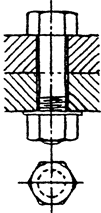
Figure 7: A hexagon head bolt
The square head bolt has a square head, is normally fitted with a square nut, and supplied black. The dimension across the flats of the head and nut is the same as that across the flats of a hexagon bolt of similar shank diameter. The head thickness is again 0.875 of the shank diameter.
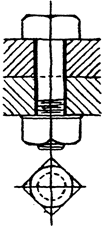
Figure 8: A square head bolt and nut
Hexagon and square head bolts are the most commonly used in engineering construction. The hexagon type gives a greater number of positions for application of the spanner than the square type and for machine or engine practice where adjustment is required, or restricted movement of spanner is possible, the hexagon type is essential.
The carriage bolt is supplied black, has a dome or cup head with a square neck, and is fitted with a square nut; the square neck assists in preventing the bolt from turning when rotating the nut. This bolt is used for holding wooden parts or holding metal parts to wood.

Figure 9: A carriage bolt and nut
The round or cheese head bolt has a cylindrical head and the outer edge is radiused or chamfered. To prevent the bolt from turning, a dowel is inserted in the body under the head. The round head bolt with dowel pin is used in machine or engine parts where a hexagon head cannot be provided.
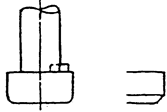
Figure 10: A round or cheese head bolt
The hook bolt (Figure 11) is useful for holding parts to flanges of steel beams, plates, and the like.
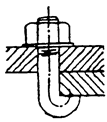
Figure 11: A hook bolt
The eye bolt is used for lifting cylinder covers, machinery, etc. The collar must be screwed hard against the surface of the job, or the threaded portion may break.

Figure 12: An eye bolt
The tap bolt or cap screw is similar to an ordinary bolt except that the screwing is continued up closer to the head and a nut is not provided.
This bolt passes through a clearance hole in the part nearest the head, and then screws into a tapped hole in the second part. If the tapped hole is blind as in Figure 13, care must be taken to ensure that there is clearance at the bottom of the bolt, or the parts will be slack.

Figure 13: A tap bolt or cap screw
The hexagon socket cap screw is often used in place of the hexagon head type in jigs, etc, where the end load on the head does not require the full head to maintain the joint.

Figure 14: A hexagon socket cap screw
Nuts, like bolts, are many and varied in shape. The two most common are the hexagon nut and the square nut.
The wing nut is used where hand tightening is sufficient:
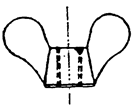
Figure 15: A wing nut
A spherical seat nut fits into a spherical recess in the job and will adjust itself to the inclination of the body of the screw.
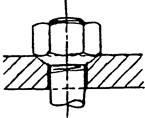
Figure 16: A spherical seat nut
A flanged nut is the equivalent of a washer and nut, and is used on machined surfaces. A cap nut is similar to the flanged nut, but also has the end solid and recessed; it is used where leakage past the threads is to be prevented. If leakage is to be prevented past the nut contact with the surface of the job, then a soft washer, say of thin copper, should be placed under the nut.
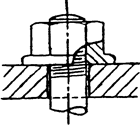 Figure 17: A flanged nut |
|
Before assembling parts with bolts and studs, run the nut down the thread to ensure it is a good fit and will travel the length of the thread without undue force. Use a lubricant such as a mixture of engine oil and graphite.
Washers are used under a bolt head or nut, to prevent damage to the parts clamped together, or to provide a satisfactory surface under the nut to enable the screw to be properly tightened.
Bolts connecting moving parts or those subject to vibration must, for safety, have some locking device fitted to prevent the nut slackening.
The common lock nut is a thin nut used in conjunction with a full size nut, the thin nut being one half the thickness of the full nut (Figure 19). The thin nut should be put on first, tightened, and then the thick nut screwed up tightly against the thin nut. The thick nut is then held by the spanner and the thin nut turned back with another spanner as far as it will go, which will be through a very small angle only. This results in a wedging action on the bolt. The outer nut carries the load and therefore should be the thicker, but the thin nut maybe on the outside as ordinary spanners may be thicker than the thin nut. (This is actually shown in Figure 19).
A compromise is often made by having two nuts, each of 2/3 to 3/4 the thickness of the standard nut (Figure 20).
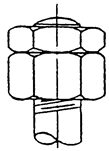 Figure 19: A lock nut |
|
A spring washer (Figure 21) is split and when closed by the nut, exerts a reaction against the nut causing a locking or wedging action. If they lose their spring they are no longer of any value as a locking device.

Figure 21: A spring washer
Figures 22 and 23 illustrate a slotted nut and a castle (or castellated) nut.
The slotted nut has a slot cut in each face of the hexagon, and the castle nut has slots cut in a cylindrical portion above the hexagon. The bolt has one hole drilled to take a split pin. When the nut is tightened, one of these slots should finish opposite the hole in the bolt and then a split pin is driven through the slot and the hole.
If the pin hole in the bolt does not come in line with the slot when the nut is tightened, the nut must be removed, and either the thickness of the washer altered or a little metal removed from the face of the nut to allow the slot and pin hole to align. The nut must not be left slack to align the slot and pin hole.
|
|
Cotter or split pins (Figure 24) are generally made from mild steel, the material being semi-circular in section. The pin should be a neat fit in the hole and the end of the pin is opened out with a chisel to prevent the pin from moving out of the hole.

Figure 24: Cotter split pin
Split pins are often placed in the ends of bolts in moving parts of engines in addition to any other locking device used; if a nut becomes loose the resultant slackness can generally be detected by the operator and the engine stopped; the split pin prevents the parts falling apart and causing serious damage before the engine can be stopped.
For example, the end of the bolt in Figure 20 is turned down below minor diameter of thread, and the pin hole drilled through this thimble end so as to just clear the nut. A cotter or split pin is inserted in the hole to prevent slackening of the nuts.
Split pins removed in overhauling should be scrapped unless they properly fit.
A stud is a double ended screw with an unthreaded portion separating the screwed ends (Figure 25). Standard manufactured studs have one short threaded end that screws tightly into a tapped hole and the length of thread on the other end is sufficient to ensure a nut does not bind. Where necessary, studs are made to accommodate double nuts.
Studs are used where access to a bolt head is difficult or impossible, or where dimensions of parts can be reduced by using studs instead of bolts as in a cylinder cover joint.

Figure 25: Use of a stud
The set screw is often used as a locking, retaining, or adjustment device. The common type of set screw is similar to a bolt except that the thread is machined to within about two pitches from the head in the type shown in Figure 26. When it is necessary to use the thread close to the head it is usual to machine a recess as shown in Figure 27.

Figure 26: A set screw
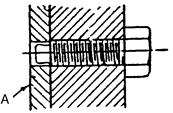
Figure 27: Use of a set screw
The smaller diameter set screws are usually inserted by the aid of a screwdriver and have heads as illustrated in Figure 28 (countersunk), Figure 29 (cheese), and Figure 30 (round). The socket head screw of Figure 14 may also be used.
Figure 28: Countersunk head |
|
|
When the set screw has no head it is called a grub screw, three forms of which are illustrated in Figures 31, 32 and 33. Grub screws are used to retain collars on shafts where the head of the ordinary set screw may be dangerous.
 Figure 31: Conical point |
|
|
If the stud projects above the surface of the work, you can:
If the stud is broken off flush or below the surface, an ‘ezy-out’ extractor (Figure 36) will generally work. A hole of suitable size is drilled in the broken stud and the extractor inserted in the hole as shown. Rotation of the tap wrench in an anti-clockwise direction will cause the ezy-out screw to bite into the metal of the stud and extract the broken section.
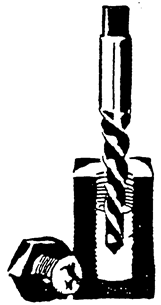
Figure 36: An ‘ezy-out’ extractor
Sometimes the stud may be started with the aid of a hammer and a diamond point chisel; where this method will not turn the stud, and in the absence of a special extractor, a hole may be drilled in the centre of the broken stud about 1.5 mm to 2.5 mm less in diameter than the minor diameter of the thread, and then a square drift tapped in with a hammer and turned with a wrench.
Should this fail to move the broken section, three equally spaced grooves may be cut in the shell with a small round nose chisel, and, if care is exercised, the remaining sections of the shell of the stud may be collapsed and removed without injury to the thread.
A little penetrating oil generally assists the operation of extracting studs.
Nuts are sometimes difficult to remove and whatever method is used to release them, you must protect the thread on the stud or bolt in preference to the nut.
Slight tapping of the nut with a hammer often releases the binding effect; a slight impact of the hammer on the end of the spanner is also often effective, but unless this method is carefully used it is possible to strain or break the stud or bolt.
Difficult cases are often handled by soaking a piece of waste in penetrating oil or kerosene, placing it on the top of the nut and allowing it to soak for some time, preferably overnight.
If subsequent hammer tapping does not allow the spanner to release the nut, slightly heat the nut using a portable gas cylinder or similar.
– British Standard Whitworth (BSW) for general engineering work
– British Standard fine (BSF) for parts subject to shock or vibration
– British Association thread (BA), for small electrical instruments and fittings
– American Standard coarse (NC), the USA equivalent to the BSW
– American Standard fine (NF), the USA equivalent of the BSF and BA in smaller sizes
– British Standard conduit thread, used for electrical installation work
|
Check your progress |
1 How are bolts classified?
2 What is the prime function of washers?
3 What is the difference between a common nut and a lock nut?
4 How does a spring washer work?
5 Describe how you would extract a broken stud.
6 What does (a) major diameter and (b) minor diameter mean when referred to threads?
7 In describing threads the following letters are used. What do these letters stand for?
(a) BSW ____________________________________________________________
(b) BSF ____________________________________________________________
(c) BSP ____________________________________________________________
(d) BA
(e) NC
(f) NF
(g) M
8 Where would you use a die nut?
9 Explain what is meant when by the pitch of a thread.
1 According to shape of head, length and type of thread.
2 To prevent damage to the parts clamped together.
3 The lock nut is one half the thickness of the full nut.
4 When closed, (eg nut tightened down) it exerts a pressure against the nut thus causing a locking or wedging effect.
5 Refer to description in this section.
6 (a) Major diameter is the full or outside diameter of a parallel thread.
(b) Minor diameter is the root or core diameter of a thread (the inside or smallest diameter).
7 (a) BSW, British Standard Whitworth
(b) BSF, British Standard Fine
(c) BSP, British Standard Pipe
(d) BA, British Association
(e) NC, American Standard National – Course
(f) NF, American Standard National – Fine
(g) Metric
8 where you need to correct a damaged or burred thread
9 The distance from the centre of the crest of one thread to the centre of the crest of the adjacent thread.
Source: http://lrr.cli.det.nsw.edu.au/LRRDownloads/5115/1/5115_1.doc
Web site to visit: http://lrr.cli.det.nsw.edu.au/
Author of the text: indicated on the source document of the above text
If you are the author of the text above and you not agree to share your knowledge for teaching, research, scholarship (for fair use as indicated in the United States copyrigh low) please send us an e-mail and we will remove your text quickly. Fair use is a limitation and exception to the exclusive right granted by copyright law to the author of a creative work. In United States copyright law, fair use is a doctrine that permits limited use of copyrighted material without acquiring permission from the rights holders. Examples of fair use include commentary, search engines, criticism, news reporting, research, teaching, library archiving and scholarship. It provides for the legal, unlicensed citation or incorporation of copyrighted material in another author's work under a four-factor balancing test. (source: http://en.wikipedia.org/wiki/Fair_use)
The information of medicine and health contained in the site are of a general nature and purpose which is purely informative and for this reason may not replace in any case, the council of a doctor or a qualified entity legally to the profession.
The texts are the property of their respective authors and we thank them for giving us the opportunity to share for free to students, teachers and users of the Web their texts will used only for illustrative educational and scientific purposes only.
All the information in our site are given for nonprofit educational purposes